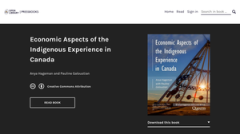Filter by

An Introduction to Mathematical Finance with Applications: Understanding and …
This textbook aims to fill the gap between those that offer a theoretical treatment without many applications and those that present and apply formulas without appropriately deriving them. The balance achieved will give readers a fundamental understanding of key financial ideas and tools that form the basis for building realistic models, including those that may become proprietary. Numerous car…
- Edition
- Ed. 1
- ISBN/ISSN
- 978-1-4939-3783-7
- Collation
- XVII, 483
- Series Title
- Springer Undergraduate Texts in Mathematics and Technology
- Call Number
- 332.46 PET i

Design of Thermal Barrier Coatings :A Modelling Approach
This book details the relationships between microstructure, interface roughness, and properties of thermal barrier coatings. The author proposes a method for the reduction of the thermal conductivity of the ceramic layer in order to increase the lifetime of thermal barrier coatings. He includes models for the optimization of ceramic layer microstructure and interface roughness
- Edition
- -
- ISBN/ISSN
- 9783319172545
- Collation
- xiv, 82 pages
- Series Title
- -
- Call Number
- 333.79

Creating a Diverse and Inclusive Organizational Culture
Students in this course will learn organizational best practices to implement diversity, equity, inclusion, and belonging in the workplace. Students will evaluate laws and policies that apply to diversity and inclusion. Students will also build cultural competencies to foster employee recruitment, motivation, satisfaction, and retention. Additionally, students will analyze the leadership skills…
- Edition
- -
- ISBN/ISSN
- -
- Collation
- -
- Series Title
- -
- Call Number
- 302 BEA c

Economic Aspects of the Indigenous Experience in Canada
In this text we are going to explore the economic history and economic potential of Indigenous communities in Canada. What institutional arrangements hold them back economically and what institutions assist them going forward? What norms do Indigenous communities hold that inform their priorities and economic behavior?
- Edition
- -
- ISBN/ISSN
- -
- Collation
- -
- Series Title
- -
- Call Number
- 330 HAG e

Open Pedagogy Approaches : Faculty, Library, and Student Collaborations
The entire spirit of this book project reflects the editors’ shared belief in the power of an open and inclusive community, of learning, and of collaboration toward innovation. From the outset, the editors knew that this book would be an open project in its own right. It had to be published openly (to practice what we preach), and it would serve as an opportunity to learn the process of creat…
- Edition
- -
- ISBN/ISSN
- -
- Collation
- -
- Series Title
- -
- Call Number
- 370 CLI o

Consumer Protection Law : A Guide for Navigating Safely in the Modern World
Overview: Consumer Protection Law: A Guide For Navigating Safely in the Modern World is an introduction to the issues consumers face every day and the protections put in place to reduce consumer harm. This text and the course it is designed to accompany is unique in undergraduate education. Most consumer protection law courses take place in either a law school setting or in only a handful of un…
- Edition
- -
- ISBN/ISSN
- -
- Collation
- -
- Series Title
- -
- Call Number
- 340 SMI c

Conservation techniques
Overview: This book fosters the recognition of options for making progress toward increased environmental conservation through an understanding of the underlying science and practice of a variety of conservation techniques. Today, there are expected benefits from integrated science and practice, and many people are promoting this as the way forward to improve our environment. Over time, trends …
- Edition
- -
- ISBN/ISSN
- -
- Collation
- -
- Series Title
- -
- Call Number
- 333 MEI c

Designing Critical and Creative Learning with Indigenous Youth : a Personal J…
- Edition
- -
- ISBN/ISSN
- 9789463003070
- Collation
- 229 pages
- Series Title
- -
- Call Number
- 370
- Edition
- -
- ISBN/ISSN
- 9789463003070
- Collation
- 229 pages
- Series Title
- -
- Call Number
- 370

Designing Inclusive Pathways with Young Adults Learning and Development for a…
This book is the second in a series entitled 'Learning and development for a better world' and it explores the potential for self-directed lifelong action learning (LAL) by focusing on the design of development pathways with and for young adults. The book considers the reasons why LAL pathways are needed and draws on innovative approaches used by the Global University for Lifelong Learning (inc…
- Edition
- -
- ISBN/ISSN
- 9789463001571
- Collation
- xxxii, 204 pages
- Series Title
- -
- Call Number
- 371.9046

Liquidity, Markets and Trading in Action : An Interdisciplinary Perspective
This open access book addresses four standard business school subjects: microeconomics, macroeconomics, finance and information systems as they relate to trading, liquidity, and market structure. It provides a detailed examination of the impact of trading costs and other impediments of trading that the authors call “frictions”. It also presents an interactive simulation model of equity mark…
- Edition
- -
- ISBN/ISSN
- 978-3-030-74817-3
- Collation
- XI, 103 halaman
- Series Title
- Classroom Companion: Business
- Call Number
- 332 OZE l
 Computer Science, Information & General Works
Computer Science, Information & General Works  Philosophy & Psychology
Philosophy & Psychology  Religion
Religion  Social Sciences
Social Sciences  Language
Language  Pure Science
Pure Science  Applied Sciences
Applied Sciences  Art & Recreation
Art & Recreation  Literature
Literature  History & Geography
History & Geography